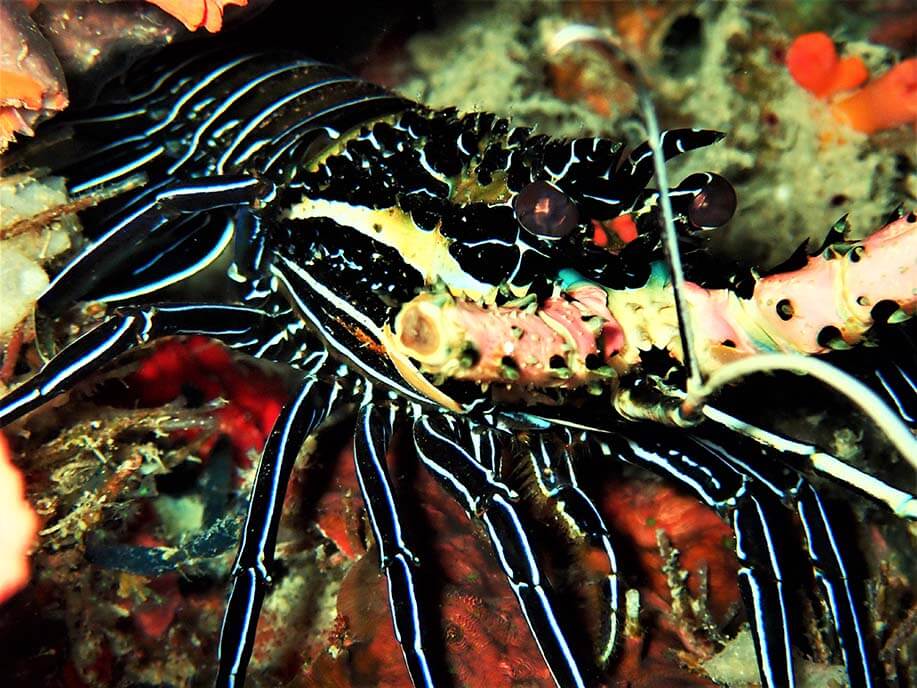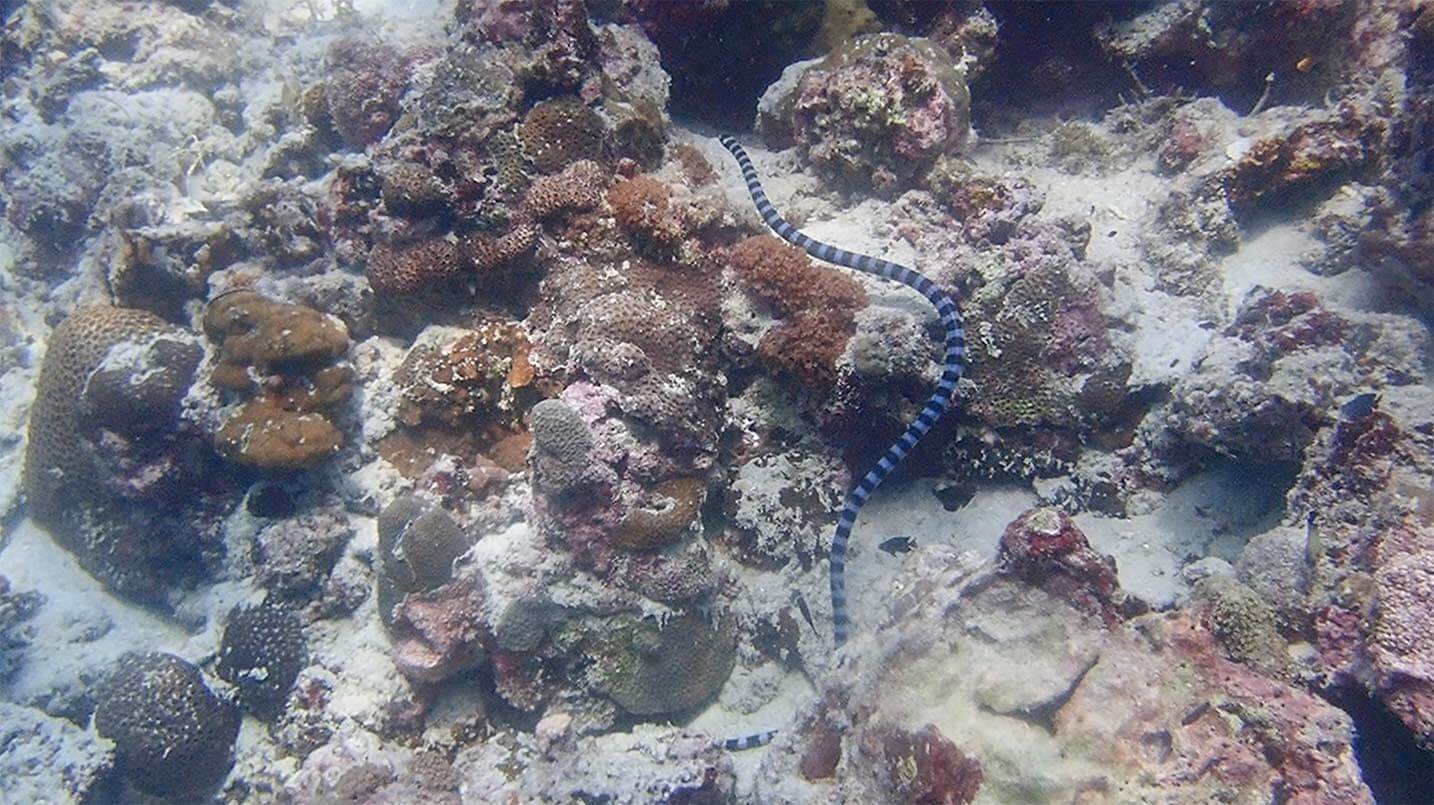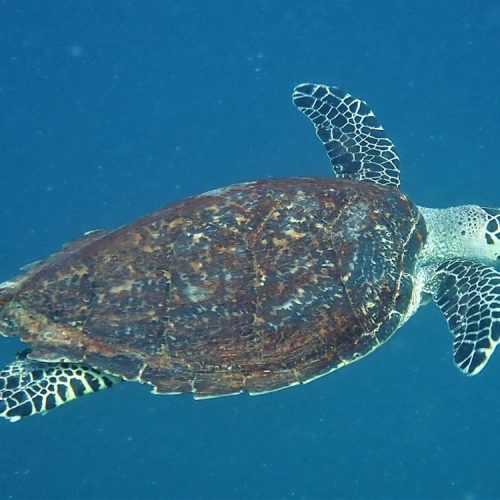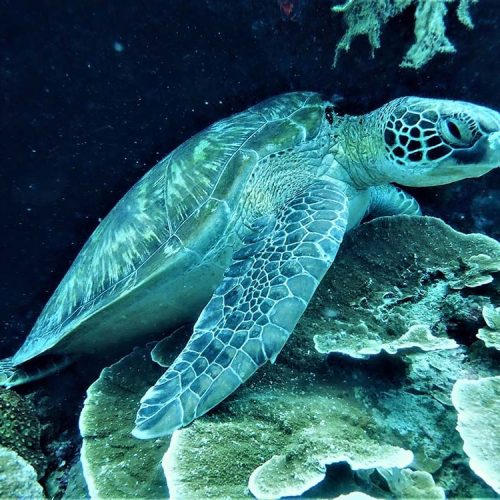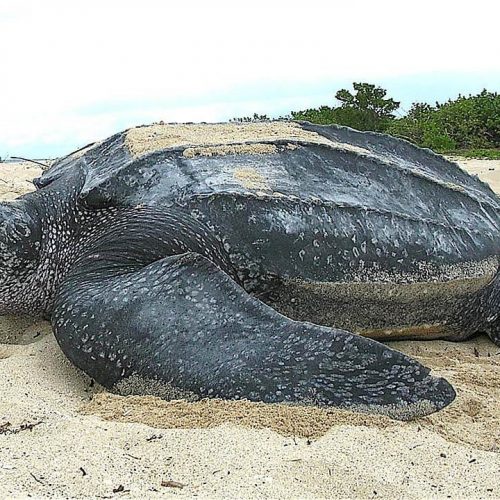Contents
The yellow-lipped sea krait (Laticauda colubrina), also known as the banded sea krait or colubrine sea krait, is a species of highly venomous snake found in tropical Indo-Pacific oceanic waters. The snake has distinctive black stripes and a yellow snout, with a paddle-like tail for use in swimming.
It spends much of its time under water to hunt, but returns to land to digest, rest, and reproduce. It has very potent neurotoxic venom, which it uses to prey on eels and small fish. Because of its affinity to land, the yellow-lipped sea krait often encounters humans, but the snake is not aggressive and only attacks when feeling threatened.
Description
The head of a yellow-lipped sea krait is black, with lateral nostrils and an undivided rostral scale. The upper lip and snout are characteristically colored yellow, and the yellow color extends backward on each side of the head above the eye to the temporal scales.[3]

The body of the snake is subcylindrical, and is taller than it is wide. Its upper surface is typically a shade of blueish gray, while the belly is yellowish, with wide ventral scales that stretch from a third to more than half of the width of the body. Black rings of about uniform width are present throughout the length of the snake, but the rings narrow or are interrupted at the belly. The midbody is covered with 21 to 25 longitudinal rows of imbricated (overlapping) dorsal scales.[3] The dorsal and lateral scales can be used to differentiate between this species and the similar yellow-lipped New Caledonian sea krait, which typically has fewer rows of scales and scales that narrow or fail to meet (versus the yellow-lipped sea krait's ventrally meeting dark bands).[4] The tail of the snake is paddle-shaped and adapted to swimming.[5]
On average, the total length of a male is 875 mm (2 ft 10.4 in) long, with a 13 cm (5.1 in) long tail. Females are significantly larger, with an average total length of 1.42 m (4 ft 8 in) and a tail length of 145 mm (5.7 in).[3]
Distribution and habitat
The yellow-lipped sea krait is widespread throughout the eastern Indian Ocean and Western Pacific. It can be found from the eastern coast of India, along the coast of the Bay of Bengal in Bangladesh, Myanmar, and other parts of Southeast Asia, to the Malay Archipelago and to some parts of southern China, Taiwan, and the Ryukyu Islands of Japan. The species is also common near Fiji and other Pacific islands within its range. Vagrant individuals have been recorded in Australia, New Caledonia, and New Zealand.[1] Six specimens have been found around the North Island of New Zealand between 1880 and 2005, suspected to have come from populations based in Fiji and Tonga.[4] It is the most common sea krait identified in New Zealand, and second-most seen sea snake after the yellow-bellied sea snake - common enough to be considered a native species, protected under the Wildlife Act 1953.[4]
Venom
The venom of this elapid, L. colubrina, is a very powerful neurotoxic protein, with a subcutaneous LD50 in mice of 0.45 mg/kg body weight.[6] The venom is an α-neurotoxin that disrupts synapses by competing with acetylcholine for receptors on the postsynaptic membrane, similar to erabutoxins and α-bungarotoxins.[7] In mice, lethal venom doses cause lethargy, flaccid paralysis, and convulsions in quick succession before death. Dogs injected with lethal doses produced symptoms consistent with fatal hypertension and cyanosis observed in human sea snake bite victims.[6]
Some varieties of eels, which are a primary food source for yellow-lipped sea kraits, may have coevolved resistance to yellow-lipped sea krait venom.[8] Gymnothorax moray eels taken from the Caribbean, where yellow-lipped sea kraits are not endemic, died after injection with doses as small as 0.1 mg/kg body weight, but Gymnothorax individuals taken from New Guinea, where yellow-lipped sea kraits are endemic, were able to tolerate doses as large as 75 mg/kg without severe injury.[9]
Behavior
Yellow-lipped sea kraits are semiaquatic. Juveniles stay in water and on adjacent coasts, but adults are able to move further inland and spend half their time on land and half in the ocean. Adult males are more terrestrially active during mating and hunt in shallower water, requiring more terrestrial locomotive ability. Adult females, though, are less active on land during mating and hunt in deeper water, requiring more aquatic locomotive ability. Because males are smaller, they crawl and swim faster than females.[5]
Body adaptations, especially a paddle-like tail, help yellow-lipped sea kraits to swim. These adaptations are also found in more distantly related sea snakes (Hydrophiinae) because of convergent evolution, but because of the differences in motion between crawling and swimming, these same adaptations impede the snake's terrestrial motion. On dry land, a yellow-lipped sea krait can still move, but typically at only slightly more than a fifth of its swimming speed. In contrast, most sea snakes other than Laticauda spp. are virtually stranded on dry land.[5]
When hunting, yellow-lipped sea kraits frequently head into deep water far from land, but return to land to digest meals, shed skin, and reproduce. Individuals return to their specific home islands, exhibiting philopatry. When yellow-lipped sea kraits on Fijian islands were relocated to different islands 5.3 km away, all recaptured individuals were found on their home islands in an average of 30.7 days.[10]
Yellow-lipped sea kraits collected near the tip of Borneo had heavy tick infections.[11]
Hunting and diet
Hunting is often performed alone, but L. colubrina kraits may also do so in large numbers in the company of hunting parties of giant trevally and goatfish. This cooperative hunting technique is similar to that of the moray eel, with the yellow-lipped sea kraits flushing out prey from narrow crevices and holes, and the trevally and goatfish feeding on fleeing prey.[12]
While probing crevices with their heads, yellow-lipped sea kraits are unable to observe approaching predators and can be vulnerable. The snakes can deter predators, such as larger fish, sharks, and birds, by fooling them into thinking that their tail is their head, because the color and movement of the tail is similar to that of the snake's head. For example, the lateral aspect of the tail corresponds to the dorsal view of the head.[13][14]
Yellow-lipped sea kraits primarily feed on varieties of eels (of the families Congridae, Muraenidae, and Ophichthidae), but also eat small fish (including those of the families Pomacentridae and Synodontidae).[15] Males and females exhibit sexual dimorphism in hunting behavior, as adult females, which are significantly larger than males, prefer to hunt in deeper water for larger conger eels, while adult males hunt in shallower water for smaller moray eels. In addition, females hunt for only one prey item per foraging bout, while males often hunt for multiple items.[5][16] After hunting, yellow-lipped sea kraits return to land to digest their prey.[10]
Courtship and reproduction

The yellow-lipped sea krait is oviparous, meaning it lays eggs that develop outside of the body.[1]
Each year during the warmer months of September through December, males gather on land and in the water around gently sloping areas at high tide. Males prefer to mate with larger females because they produce larger and more offspring.[17]
When a male detects a female, he chases the female and begins courtship. Females are larger and slower than males, and many males escort and intertwine around a single female. The males then align their bodies with the female and rhythmically contract; the resulting mass of snakes can remain nearly motionless for several days.[17][18] After courtship, the snakes copulate for about an average of two hours.[17]
The female yellow-lipped sea kraits then lay as many as 10 eggs per clutch. The eggs are deposited in crevices where they remain until hatching.[19] These eggs are very rarely found in the wild; only two nests have been definitively reported throughout the entire range of the species.[1]
Interaction with humans
Because yellow-lipped sea kraits spend much of their time on land, they are often encountered by humans. They are frequently found in the water intake and exhaust pipes of boats.[19] They are also attracted to light and can be distracted by artificial sources of light, including hotels and other buildings, on coasts.[1]
Fewer bites from this species are recorded compared to other venomous species such as cobras and vipers, as it is less aggressive and tends to avoid humans.[15] If they do bite, it is usually in self-defense when accidentally grabbed. Most sea snake bites occur when fishermen attempt to untangle the snakes from their fishing nets.[20]
In the Philippines, yellow-lipped sea kraits are caught for their skin and meat; the meat is smoked and exported for use in Japanese cuisine.[1] The smoked meat of a related Laticauda species, the black-banded sea krait, is used in Okinawan cuisine to make irabu-jiru (Japanese: イラブー汁, irabu soup).[21]
References
- ^ a b c d e f Lane, A.; Guinea, M.; Gatus, J.; Lobo, A. (2010). "Laticauda colubrina". IUCN Red List of Threatened Species. 2010: e.T176750A7296975. doi:10.2305/IUCN.UK.2010-4.RLTS.T176750A7296975.en. Retrieved 19 November 2021.
- ^ Laticauda colubrina at the Reptarium.cz Reptile Database
- ^ a b c Smith, M.A. (1943). The Fauna of British India, Ceylon and Burma, Including the Whole of the Indo-Chinese Sub-region. Vol. Reptilia and Amphibia. Vol. III.—Serpentes. London: Secretary of State for India. (Taylor and Francis, printers). p. 443.
- ^ a b c Gill, B.J.; Whitaker, A.H. (2014). "Records of sea-kraits (Serpentes: Laticaudidae: Laticauda) in New Zealand". Papahou: Records of the Auckland Museum. 49: 39–42. ISSN 1174-9202. JSTOR 43264621. Wikidata Q58629017.
- ^ a b c d Shine, R.; Shetty, S. (2001-03-01). "Moving in two worlds: aquatic and terrestrial locomotion in sea snakes (Laticauda colubrina, Laticaudidae)". Journal of Evolutionary Biology. 14 (2): 338–346. doi:10.1046/j.1420-9101.2001.00265.x. ISSN 1420-9101. S2CID 82676695.
- ^ a b Levey, Harold A. (1969-05-01). "Toxicity of the venom of the sea-snake, Laticauda colubrina, with observations on a Malay 'folk cure'". Toxicon. 6 (4): 269–276. Bibcode:1969Txcn....6..269L. doi:10.1016/0041-0101(69)90095-6. PMID 5805121.
- ^ Sato, S.; Yoshida, H.; Abe, H.; Tamiya, N. (1969-10-01). "Properties and biosynthesis of a neurotoxic protein of the venoms of sea snakes Laticauda laticaudata and Laticauda colubrina". Biochemical Journal. 115 (1): 85–90. doi:10.1042/bj1150085. ISSN 0264-6021. PMC 1185071. PMID 5346371.
- ^ Heatwole, Harold; Poran, Naomie S. (1995-01-01). "Resistances of Sympatric and Allopatric Eels to Sea Snake Venoms". Copeia. 1995 (1): 136–147. doi:10.2307/1446808. JSTOR 1446808.
- ^ Heatwole, Harold; Powell, Judy (1998-05-08). "Resistance of eels (Gymnothorax) to the venom of sea kraits (Laticauda colubrina): a test of coevolution". Toxicon. 36 (4): 619–625. Bibcode:1998Txcn...36..619H. doi:10.1016/S0041-0101(97)00081-0. PMID 9643474.
- ^ a b Shetty, Sohan; Shine, Richard (2002-01-01). "Philopatry and Homing Behavior of Sea Snakes (Laticauda colubrina) from Two Adjacent Islands in Fiji". Conservation Biology. 16 (5): 1422–1426. Bibcode:2002ConBi..16.1422S. doi:10.1046/j.1523-1739.2002.00515.x. JSTOR 3095337. S2CID 86013129.
- ^ Clark, M.; Oakley, S. (2011-03-08). "Sea snake parasites – 1". Tropical Research and Conservation Centre. Archived from the original on 2016-03-04. Retrieved 2016-08-20.
- ^ Produced by Mark Brownlow (2006-11-26). "Shallow Seas". Planet Earth. BBC. BBC One.
- ^ Rasmussen, A.R.; Elmberg, J. (2009). "'Head for my tail': A new hypothesis to explain how venomous sea snakes avoid becoming prey". Marine Ecology. 30 (4): 385–390. doi:10.1111/j.1439-0485.2009.00318.x.
- ^ "Sea snake's two-headed illusion". BBC News. 6 August 2009. Retrieved 7 October 2012.
- ^ a b "Laticauda colubrina Colubrine or yellow-lipped sea krait". Animal Diversity Web. University of Michigan Museum of Zoology.
- ^ Shetty, S.; Shine, R. (2002-02-01). "Sexual divergence in diets and morphology in Fijian sea snakes Laticauda colubrina (Laticaudinae)". Australian Ecology. 27 (1): 77–84. Bibcode:2002AusEc..27...77S. doi:10.1046/j.1442-9993.2002.01161.x. ISSN 1442-9993.
- ^ a b c Shetty, Sohan; Shine, Richard (2002-01-01). "Activity Patterns of Yellow-Lipped Sea Kraits (Laticauda colubrina) on a Fijian Island". Copeia. 2002 (1): 77–85. doi:10.1643/0045-8511(2002)002[0077:apoyls]2.0.co;2. JSTOR 1447926. S2CID 55800239.
- ^ Shetty, Sohan; Shine, Richard (2002-01-01). "The Mating System of Yellow-Lipped Sea Kraits (Laticauda colubrina: Laticaudidae)". Herpetologica. 58 (2): 170–180. doi:10.1655/0018-0831(2002)058[0170:tmsoys]2.0.co;2. JSTOR 3893192. S2CID 86240716.
- ^ a b Guinea, Michael L. (1994). "Sea snakes of Fiji and Niue". In Gopalakrishnakone, Ponnampalam (ed.). Sea Snake Toxicology. Singapore Univ. Press. pp. 212–233. ISBN 978-9971-69-193-6.
- ^ Karleskint, George; Small, James; Turner, Richard (2009). "Introduction to Marine Biology". Cengage Learning. p. 307. ISBN 978-0-495-56197-2.
- ^ "Sea snake soup (Irabu-jiru)". Okinawa Gourmet Guide. En.okinawa2go.jp. Archived from the original on 26 February 2017. Retrieved 2016-07-17.
Further reading
- Boulenger, G.A. (1896). Catalogue of the Snakes in the British Museum (Natural History). Volume III., Containing the Colubridæ (Opisthoglyphæ and Proteroglyphæ) ... London: Trustees of the British Museum (Natural History). (Taylor and Francis, printers). xiv + 727 pp. + Plates I-XXV. (Platurus colubrinus, pp. 308–309).
- Das, I. (2002). A Photographic Guide to Snakes and other Reptiles of India. Sanibel Island, Florida: Ralph Curtis Books. 144 pp. ISBN 0-88359-056-5. (Laticauda colubrina, p. 56).
- Das, I. (2006). A Photographic Guide to Snakes and other Reptiles of Borneo. Sanibel Island, Florida: Ralph Curtis Books. 144 pp. ISBN 0-88359-061-1. (Laticauda colubrina, p. 69).
- Frith, C.B. (1974). "Second record of the seasnake Laticauda colubrina in Thailand waters". Nat. Hist. Bull. Siam Soc. 25: 209.
- Ota, Hidetoshi; Takahashi, Hiroshi; Kamezaki, Naoki (1985). "On specimens of yellow lipped sea krait Laticauda colubrina from the Yaeyama group, Ryūkyū Archipelago". Snake. 17: 156–159.
- Pernetta, J.C. (1977). "Observations on the habits and morphology of the sea snake Laticauda colubrina (Schneider) in Fiji". Canadian Journal of Zoology. 55 (10): 1612–1619. Bibcode:1977CaJZ...55.1612P. doi:10.1139/z77-210.
- Schneider, J.G. (1799). Historiae Amphibiorum naturalis et literariae Fasciculus Primus continens Ranas, Calamitas, Bufones, Salamandras et Hydros. Jena: F. Frommann. xiii + 264 pp. + corrigenda + Plate I. (Hydrus colubrinus, new species, pp. 238–240). (in Latin).
- Shetty, Sohan; Devi Prasad, K.V. (1996). "Geographic variation in the number of bands in Laticauda colubrina". Hamadryad. 21: 44–45.
- Stejneger, L. (1907). Herpetology of Japan and Adjacent Territory. United States National Museum Bulletin 58. Washington, District of Columbia: Smithsonian Institution. xx + 577 pp. (Laticauda colubrina, new combination, pp. 406–408).
- Voris, Harold K.; Voris, Helen H. (1999). "Commuting on the tropical tides: the life of the yellow-lipped sea krait Laticauda colubrina ". Reptilia (Great Britain) (6): 23–30.


